Readers must familiarize themselves with these subtopics to understand the concepts discussed in this chapter. These articles are linked within this chapter, but it may be easier to read them in advance.
Artillery Resupply - a neglected problem
The ERGM Fiasco - an impractical idea
Artank - the artillery/tank combo
EFOGM - video guided missiles
RAH-60 Gunhawks - use the AC-130 concept to fire downward
AGM-122 Sidearm - why is this ignored?
Fiber Optic Guided Bombs - the ultimate airpower weapon
________________________________________________________
Artillery is vast subject, which must include Close Air Support (CAS) since their mission is similar. Artillery is key to warfare, but is not the "King of Battle" it has been in the past. This is because airpower has become much more accurate and attack helicopters now provide very mobile direct fire support. In addition, armored units have much more powerful direct fire weapons. For example, the US Army now fields 120mm tank guns vs. the 76mm guns of World War II, while 25mm guns on Bradley's substitute for 12.7mm (.50 caliber guns). In addition, these guns have become far, far more deadly with laser range finders and stabilized platforms that allow accurate fire while on the move.
A major problem with artillery is that it consumes a great deal of ammunition and is manpower intensive. The section on Artillery Resupply provides details. This supply problem was a big driver behind all the precision-guided munitions developments and one reason the attack helicopter became so popular. Since moving ammo to the gun system is hard, then move the gun system to the ammo. Mobile armored forces are truly "Hell on Wheels" so long as they can be supplied. However, artillery units are the king of supply requirements since they fire huge quantities of munitions at area targets. As a result, they become a hindrance to mobile armored forces as supply lines become clogged with trailing artillery units, which need supplies as well.
Excalibur & APKWS
A valuable weapon ignored by the U.S. Army and Marine Corps is the GPS-guided Tomahawk missiles fired from ground launchers. These can deliver a 1000 lb warhead against a high-value target up to 700 miles away, compared to just 100 miles for the Army's current longest range missile. Even a HMMWV can carry a Tomahawk, but since it has so much range it needn't move often so a simple trailer launch system is ideal. Ironically, the Navy test fires Tomahawks from simple ground launchers. (below)
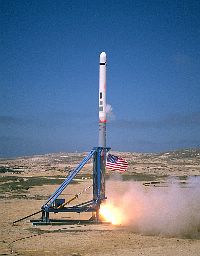 Tactical Tomahawk controllers have the capability
to reprogram the missile while in-flight to strike any of 15 preprogrammed
alternate targets or redirect the missile to any Global Positioning System (GPS)
target coordinates. It is able to loiter over a target area for an hour, and
with its on-board TV camera, allows the warfighting commanders to assess battle
damage of the target, and, if necessary redirect the missile to any other
target. A joint system could allow Army units ashore to control Tomahawks
fired from distant Navy ships. If Navy ships are too far from the
action, the Army can borrow Tomahawks from Navy ships and move them
far inland for use. A large joint Army/Navy buy could also drive down the unit
cost, which is currently over $1,000,000.
Tactical Tomahawk controllers have the capability
to reprogram the missile while in-flight to strike any of 15 preprogrammed
alternate targets or redirect the missile to any Global Positioning System (GPS)
target coordinates. It is able to loiter over a target area for an hour, and
with its on-board TV camera, allows the warfighting commanders to assess battle
damage of the target, and, if necessary redirect the missile to any other
target. A joint system could allow Army units ashore to control Tomahawks
fired from distant Navy ships. If Navy ships are too far from the
action, the Army can borrow Tomahawks from Navy ships and move them
far inland for use. A large joint Army/Navy buy could also drive down the unit
cost, which is currently over $1,000,000.
One of the worst Army ideas is the GPS-guided 155mm Excalibur artillery round. This is a second attempt to make a GPS guided artillery round. The first failed attempt was called ERGM and was funded by the US Navy for a decade. It failed because of high unit costs and problems with electronics damage from high-G firings. With a unit cost of over $200,000 per 90 lb projectile, these have half the explosive power of 155mm rounds since the GPS electronics need space in the warhead. Finally, programming the GPS coordinates into each projectile takes time, which slows the rate of fire. Another bad idea in the US Army is the Advanced Precision Kill Weapon System II (APKWS II), a 70mm missile with a laser seeker (like the 178mm Hellfire missile) fired from current rocket launchers. These cost nearly as much as a $100,000 Hellfire, yet deliver one-quarter the firepower and are too small to knock out tanks.
An artillery piece is expensive to procure, man, and operate but it can place inexpensive firepower on target. If expensive electronics are used for precision guidance, the warhead must be very large to justify the high-cost, something in the range of 100 lbs of high-explosive. In addition, if an expensive weapon has its own guidance, it does not need an expensive, complex, and heavy launcher like a howitzer. Therefore, it makes no sense to develop precision-guided munitions for howitzers. A howitzer exerts much greater G forces on electronic components than a missile launch. While gun tolerant electronics have been developed, they are more complex, more expensive, and more likely to fail. In summary, missiles are best for expensive precision-guided munitions since they have a soft launch, do not require a heavy, expensive, and complex launch system, and deliver far greater firepower per round.
The Problem with Howitzers 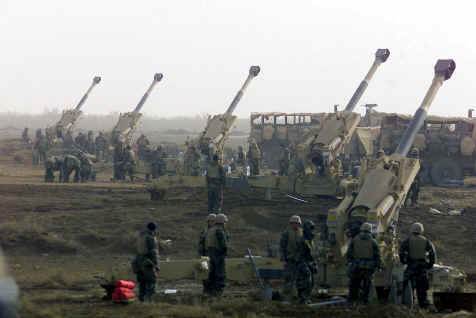
A big drawback for howitzers is a low rate of fire compared to what a rocket system can deliver. This is a fatal problem for howitzers now that counterbattery radar is common throughout the world since an enemy can determine the exact location of a firing battery before its first volley of projectiles land. This has made towed artillery (pictured) obsolete in modern warfare, and made self-propelled artillery operations complex and limited. While modern self-propelled howitzers are protected by light armor, many of their command and support vehicles are not, and neither are the trucks and forklifts unloading ammo nearby.
Firing ballistic rounds broadcasts the grid coordinate of a firing battery. Modern counterbattery radar can direct a single enemy rocket system to unleash a massive counterfire within seconds equivalent to what a 18-tube howitzer battalion can deliver in a few minutes. In addition, new weapons like EFOGMs are very effective if provided with the specific location of enemy vehicles, something counterbattery radar can provide. Armies may soon field huge EFOGMs with 1000 lb warheads that can blast targets just like an airstrike.
Howitzers must limit their sustained rate of fire to
one round a minute to avoid barrel overheating and these barrels wear out and must be routinely
replaced, which is an expensive and time-consuming affair. Modern
howitzers are very expensive to procure and maintain. The self-propelled
are heavyweight like a tank, which increases the deployment problem and the fuel
sustainment challenge. They are also slow compared to combat vehicles so
they lag behind in fast, mobile operations and are often unable to provide
fire support
when needed. Lastly, howitzers are manpower intensive and complex,
requiring highly trained personnel to deal with the assortment of projectiles,
fuzes, and bag charges. In contrast, rockets for systems like MLRS (pictured)
arrive in factory packages. They snap-in and are ready to fire by
lesser trained troops.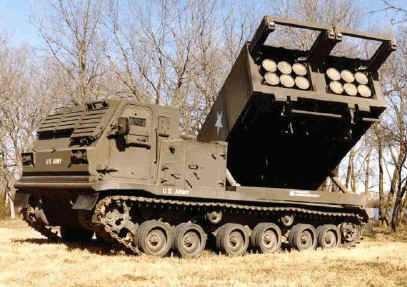
Self-propelled howitzers are accurate but a burden that can be eliminated. This is a major change for an army, like when horse cavalry was disbanded. Some of their firepower may be replaced by multi-role Artanks, heavily armored vehicles that can fire directly like tanks and indirectly like self-propelled artillery. Tanks have been used as artillery in past wars simply by parking upward on a slope to provide more elevation. Artanks are much better armored to survive counterbattery fires, and their flat trajectory gunfire is more difficult to track with counterbattery radar.
Light Artillery
One of the most feared weapons in World War II were multiple rocket launchers. For some reason, American artillerymen lost interest in them, probably because they are too simple to operate, just aim and fire away. In contrast, the operation of a howitzer is complex and requires the coordination of a squad of trained men to steadily fire one round at a time. Howitzers are more accurate than unguided rockets, but their cost, weight, slow rate of fire, and manpower requirement make them impractical. Autoloaders are sold as a partial solution, but who loads the autoloader? Soldiers!
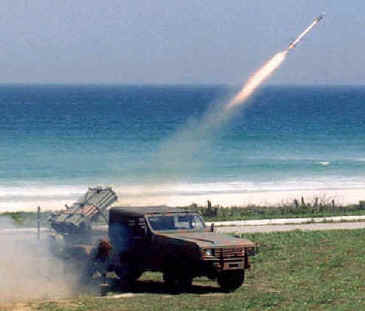 The Brazilian Avibras Skyfire Rocket system (left) is a modern version of a basic 70mm rocket launcher using composite
propellant, wraparound fins, and powerful warheads. It has a range of 12km and can saturate a large area within 12 seconds. The US military can easily construct
a similar system by mounting current 70mm helicopter rocket launchers on HMMWVs or
M-113s.
This
provides instant "hip pocket" artillery support to advancing units and may
be fired directly at targets.
The Brazilian Avibras Skyfire Rocket system (left) is a modern version of a basic 70mm rocket launcher using composite
propellant, wraparound fins, and powerful warheads. It has a range of 12km and can saturate a large area within 12 seconds. The US military can easily construct
a similar system by mounting current 70mm helicopter rocket launchers on HMMWVs or
M-113s.
This
provides instant "hip pocket" artillery support to advancing units and may
be fired directly at targets.
These rocket mounts should also be capable of mounting Hellfire missiles, exactly like those found on helicopters. With a range of over ten miles, forward observers or tiny scout helicopters armed with a laser designator can request precision missile support by providing a grid. The requested number of Hellfires can be fired a few seconds apart indirectly toward that grid where they home-in on the laser spot provided by a forward observer for an exact hit.
Such a weapon system is simple for the US Army to construct since it is already functional on AH-64 Apache attack helicopters. These have four hardpoints on two stub wings. (below left) Each hardpoint can be fitted with a 70mm rocket launcher pod or a four-pack of Hellfire missiles. A ground version could have a "T" turret with two identical stub wings, similar to the Hammerhead turret used for TOW missiles. (below right) This allows the exact same Apache configurations. The gunner sits in the middle just like an Apache helicopter pilot and can pivot the "T" left or right, and turn the stub wings up and down to adjust range. The Apache chin mounted 30mm autocannon could be "head mounted" atop the vehicle. This "Ground Apache" could provide effective long-range direct or indirect fire support, equipped with a laser designator or Longbow radar for the Hellfires. This system could also be effective against aircraft if a heat-seeking Sidewinder missile is mounted on each wing tip, just like with the Apache.
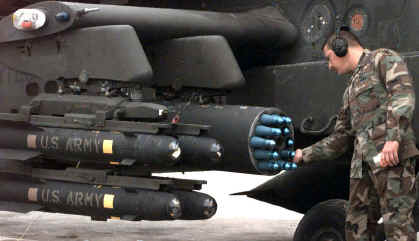
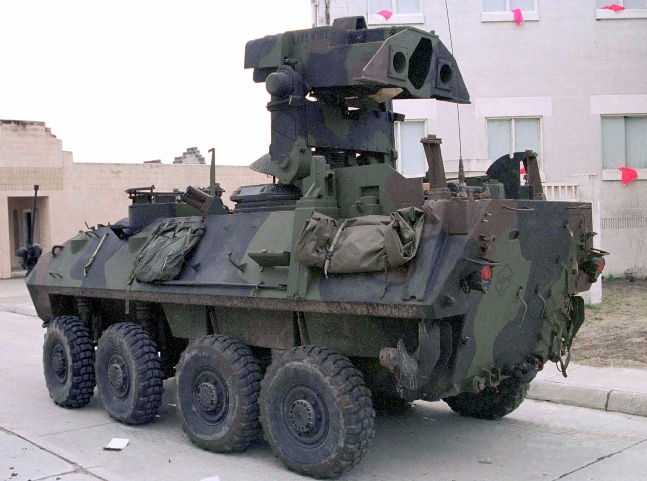
One drawback to current 70mm rocket systems is the manpower and time required to reload the pods. Each rocket must be unpacked and individually loaded. This allows different mixes of rockets to be used, but in many cases only high-explosive rockets are needed. The answer is to copy MLRS and use factory-packed disposable pods. The pods can be lighter since they will only be used once, and perhaps larger to carry more rockets. A standard forklift would be required to mount a new pod in two minutes, rather than 30 minutes needed to unpack and load each rocket by hand. Another option is a elliptical shaped pod with ~100 70mm high-explosive rockets that snaps into two hardpoints. These are likely to become popular in attack helicopter squadrons as well. Traditional hand-loaded pods would remain in service to fire varied rockets, but pre-packaged pods would be used for most missions.
Mortars
Mortars are an old, lightweight, simple weapon. The "large" 120mm mortar is so small that it can be carried by a light truck and internally in light helicopters. Mortars can fire into defilade positions, unlike guns and rocket systems. They can be carried up hillsides or up buildings to emplace anywhere. One problem is counterbattery radar. However, since mortars are small, they can be quickly dug into protected positions where they are difficult for attack helicopters and EFOGM gunners to locate. If they are destroyed, they are very inexpensive and easy to replace.
An advantage for mortars is they are best to employ sensor-guided munitions, like the Swedish 120mm STRIX round with an infrared seeker. Since a mortar bomb has a relatively modest velocity, the g-force exerted at launch is far less than from a gun or howitzer, so the problems with electronic seeker damage are much less. In addition, since a mortar round falls straight down, it allows a seeker a better and longer view of the target below, whereas a ballistic howitzer round arrives at an angle. This is why 155mm howitzer-fired sensor-guided munitions like SADARM and BONUS require a complex cargo projectile that breaks open in flight and releases two smaller sub-munitions that have less penetrating power than an entire mortar round.
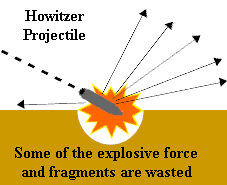
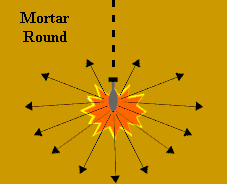 Since
a mortar round descends nearly vertically in the final part of its trajectory, it
avoids obstacles and provides a perfect 360 degree daisy cutter explosion. This is critical in dense urban terrain and forests where indirect howitzer
fire is of little value since a round is likely to strike a building or tree during its
ballistic path to target. In 1944, American infantry suffered 33,000 killed when
it attempted to advance in the dense German Hurtgen Forest in part because
American howitzer rounds usually exploded in the trees above friendly forces. The Israelis found the Soviet designed 160mm Soltam
heavy mortar was their most effective weapon in Beirut, while the Russians learned
the same lesson a decade later fighting rebels in Grozny. Given their limited
range, mortars are best for organic battalion-level firepower.
Since
a mortar round descends nearly vertically in the final part of its trajectory, it
avoids obstacles and provides a perfect 360 degree daisy cutter explosion. This is critical in dense urban terrain and forests where indirect howitzer
fire is of little value since a round is likely to strike a building or tree during its
ballistic path to target. In 1944, American infantry suffered 33,000 killed when
it attempted to advance in the dense German Hurtgen Forest in part because
American howitzer rounds usually exploded in the trees above friendly forces. The Israelis found the Soviet designed 160mm Soltam
heavy mortar was their most effective weapon in Beirut, while the Russians learned
the same lesson a decade later fighting rebels in Grozny. Given their limited
range, mortars are best for organic battalion-level firepower.
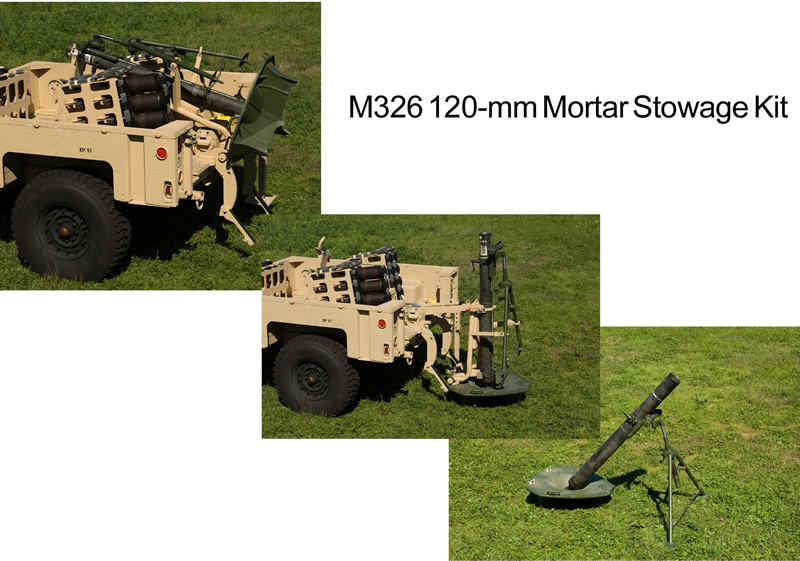 This
video
clearly shows why tube artillery is obsolete. It is difficult to move and
requires a dozen soldiers running about in a complex dance to fire the thing.
The video shows rapid fire of a 155mm gun, but after a dozen rounds they must
slow to "sustained" fire of one every couple of minutes lest the
barrel warp. Simple counter-battery radar can quickly detect its exact
location for immediate destruction. MLRS is far superior for large targets,
while 120mm mortars are far better for small targets.
This
video
clearly shows why tube artillery is obsolete. It is difficult to move and
requires a dozen soldiers running about in a complex dance to fire the thing.
The video shows rapid fire of a 155mm gun, but after a dozen rounds they must
slow to "sustained" fire of one every couple of minutes lest the
barrel warp. Simple counter-battery radar can quickly detect its exact
location for immediate destruction. MLRS is far superior for large targets,
while 120mm mortars are far better for small targets.
For mobile units, the US Army's 120mm mortar mounted inside an M113 APC is great, which the US Marines should copy and mount inside AAVs. For light forces, the BAE 326 mortar system (pictured) is great. Its hydraulic arm can instantly place or pick up the 300 lb. mortar with base plate, even if stuck in mud after firing. Each should be accompanied by another HMMWV full of ammo. Mortars can also provide anti-armor firepower using IR guided munitions.
Future Artillery Organization
As these newer systems are fielded, traditional 105mm and 155mm howitzers should retire. Their cost, complexity, weight, vulnerability to counterbattery radar, and manpower requirement make them ineffective weapons compared to alternatives.
= Proposed Division Artillery Battalion
- H&S Company
- EFOGM Battery
- Missile Battery, with 70mm rocket pods and 178mm Hellfires
- 120mm Mortar Battery
- MLRS Battery
This provides less "sustained" firepower than today's artillery battalions, but it is much lighter and requires far less manpower and supplies. Sustained is emphasized because the missile battery can produce much more firepower within a minute that an entire howitzer battalion. Artillery battalions could be mounted on light trucks instead of tracked APCs to cut deployment weight and fuel consumption in half. Elements are likely to be attached to maneuver battalions depending on each situation. Batteries should have organic resupply vehicles to ensure these systems are fully utilized during mobile operations. The mortars provide basic bombardment, EFOGMs provide precision artillery, while the missile battery provides all these capabilities, plus anti-tank and anti-aircraft.
x Proposed Corps Artillery Brigade - general support for several divisions
= one MLRS battalion
= one attack helicopter battalion (AH-64)
= one aerial artillery battalion (AH-60/EH-60)
= one Tomahawk battalion
With the loss of howitzers, the MLRS-TACMS penetrator rockets should be procured for use against fortified positions. These have a delayed fuze so they penetrate deep into the earth before detonation. The addition of a fixed-wing Aerial Command Brigade for fire support coordination with OV-6C Rangers, E-2D Hawkeyes, S-2 Hawkears, and KC-2 Hawkgas is discussed in Chapter 11. They can provide far greater battlefield awareness to ensure that Corps firepower is efficiently allocated. The number of expensive attack helicopters has been slashed in comparison to the current US Army structure in which each Corps has several attack helicopter battalions. These are available to provide general support, but most direct attack helo support will be provided by tiny organic Scout helicopters or when massed for an AirCav attack.
The aerial artillery battalion is designed to provide general support artillery over a Corps area using a basic helicopter like the H-60 Blackhawk. These are not expensive armored attack helicopters, but carry can an impressive load of firepower in the form of four 70mm rocket pods or 16 Hellfire missiles. However, a new type of over-the-horizon weapon is needed to provide aerial artillery in high-threat environments. One option are 178mm Hellfire-size rockets with a range of over 10 miles, similar to Navy 5-inch (127mm Zuni rockets). These can be cheap, dumb Hellfires employed like rocket with no guidance so a much larger high-explosive warhead is possible.
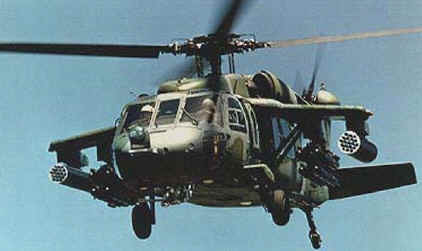 An AH-60 Blackhawk
(pictured) armed with dumb Hellfires
could fire
a volley of 16 large 178mm rockets at a distant area target and then depart
unseen by the enemy or encountering his air defense systems. This requires a fire control system in which a soldier inputs the
normal artillery variances of winds, temperature, and humidity, as well as the range
or exact grid if available. The computer then provides the
pilot with an aim point that requires him to point the helicopter in that exact
direction and pitch. When ready, the fire button is pushed to allow the
automatic firing of 178mm rockets in rapid succession, yet the computer only fires them
when the helicopter is in the proper position. Given the problem with
winds and the possible need to elevate the nose to reach longer range targets,
it may take over a minute to fire all 16 rockets as the pilot struggles to satisfy
the computer's demand for the exact positioning required to accurately fire each
unguided Hellfire rocket. Another option are even larger rockets, like the MLRS version
with a GPS guidance system to greatly
improve accuracy.
An AH-60 Blackhawk
(pictured) armed with dumb Hellfires
could fire
a volley of 16 large 178mm rockets at a distant area target and then depart
unseen by the enemy or encountering his air defense systems. This requires a fire control system in which a soldier inputs the
normal artillery variances of winds, temperature, and humidity, as well as the range
or exact grid if available. The computer then provides the
pilot with an aim point that requires him to point the helicopter in that exact
direction and pitch. When ready, the fire button is pushed to allow the
automatic firing of 178mm rockets in rapid succession, yet the computer only fires them
when the helicopter is in the proper position. Given the problem with
winds and the possible need to elevate the nose to reach longer range targets,
it may take over a minute to fire all 16 rockets as the pilot struggles to satisfy
the computer's demand for the exact positioning required to accurately fire each
unguided Hellfire rocket. Another option are even larger rockets, like the MLRS version
with a GPS guidance system to greatly
improve accuracy.
If a spotter is on the scene, the helicopter may fire just one rocket at a time so minor adjustments can be made before unleashing all them for "fire for effect." If spotters have a laser designator, guided Hellfires may be employed. Part of this concept of aerial artillery is placing armed Blackhawks "on station" yet on the ground behind advancing mobile forces to await calls for fires. This allows them to remain forward and ready for hours until their support is requested. They take off, quickly deliver their firepower, and then fly home to an airbase, which may be a hundred miles to the rear, to rearm and refuel. Aerial artillery battalions may include several RAH-60 Gunhawks to provide unique support in urban fighting and areas where the air defense threat is minimal by firing directly downward.
This proposal is serious about electronic warfare. The US Army has EH-60 helicopters for airborne electronic warfare detection and jamming, yet just a couple dozen are in frontline service. These aircraft must play a more active role in combat operations. First, they should be equipped with radar-homing missiles like the AGM-122 Sidearm so they can immediately attack enemy radar sites they detect. This missile must be modified so it can also attack enemy UAV controllers by homing-in on their radio signals.
This battalion should also have Blackhawks with the ability to locate artillery and mortars using a counterbattery sensor system. This would be extremely valuable for mobile forces because it takes time to set up counterbattery radar at a good, elevated location. Airborne counterbattery sensors exist, but the development problem seems to be a strange requirement to fit everything into a small UAV, whereas a Blackhawk has plenty of room and can carry personnel to relay information directly to ground units and fire support coordinators.
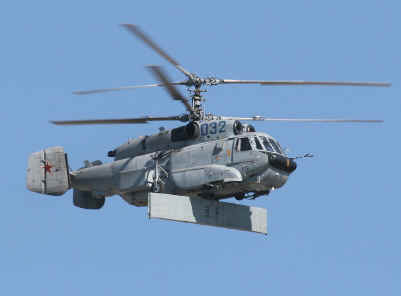 The Russians
sell a helicopter called the Ka-31that has a large rotating "Oko"
radar panel underneath the fuselage, (pictured) which allows the helicopter to act
as a radar picket to warn of incoming aircraft. There is no reason why a
helicopter cannot carry a large, modern Active Electronically Scanned Array (AESA)
radar panel in that
manner. In 2002, BAE Systems developed the world's first production AESA
radar for helicopters called the Seaspray 7000E. This technology may prove
valuable for EH-60s. Another option is the small, lightweight millimeter wave radar
available from BAE Systems. This W-band, 94-GHz radar measures 24 x 10 x 9 inches
and weighs 100 lbs, so it can be fitted on the nose of EH-60s. (see Aviation
Week 11-28-05)
The Russians
sell a helicopter called the Ka-31that has a large rotating "Oko"
radar panel underneath the fuselage, (pictured) which allows the helicopter to act
as a radar picket to warn of incoming aircraft. There is no reason why a
helicopter cannot carry a large, modern Active Electronically Scanned Array (AESA)
radar panel in that
manner. In 2002, BAE Systems developed the world's first production AESA
radar for helicopters called the Seaspray 7000E. This technology may prove
valuable for EH-60s. Another option is the small, lightweight millimeter wave radar
available from BAE Systems. This W-band, 94-GHz radar measures 24 x 10 x 9 inches
and weighs 100 lbs, so it can be fitted on the nose of EH-60s. (see Aviation
Week 11-28-05)
In low intensity operations, EH-60s could use counterbattery sensor systems to pinpoint machine gun and sniper fire below by tracking those tiny projectiles. In higher threat environments, EH-60s with a counterbattery sensors could track anti-aircraft fires from a distance. Support may be requested after attack helicopters or attack jets encounter an area with heavy ground fire. EH-60s and AH-60s arrive on the scene to support an attack and loiter at a safe distance. As aircraft make strafing runs, rising enemy projectiles can be detected by the EH-60s that immediately calculate their origin and provide AH-60s data within seconds. The AH-60s fire a barrage of rockets at these targets using indirect fire or GPS-guided missiles. This would provide an important capability that is not available today.
Finally, this brigade should include a cruise missile battalion. Its basic mission is to program and ground-launch Tomahawk missiles in support of tactical operations. However, it will have an important secondary mission of helping employ Navy Tomahawk missiles to support soldiers far inland. These soldiers may spend much time on ships or at major headquarters to provide direct input so that Navy cruise missiles can be fired quickly to support soldiers fighting hundreds of miles inland. A system where a specific destroyer is assigned to support a specific brigade can work well. A third mission for soldiers in this battalion is to understand and help coordinate naval gunfire support. If the US Navy adopts the MK-71 8-inch Naval Gun, that gun can provide heavy, sustained firepower some 40 miles inland. This is an area of total neglect by the US Army today.
No Tube Artillery Allows More Combat Power
These proposed artillery units provide less firepower than today's Division/Corps structure. However, a fixed-wing Aerial Command Brigade can provide a great leap forward in fire support coordination and allocation. In addition, this organization requires one-third the manpower and logistics of today's artillery, mostly because this force is much lighter and consumes far less fuel. The only large combat vehicles are found in the MLRS battalions. As a result, the need for hundreds of fuel trucks clogging the main supply routes is slashed, especially since helicopter artillery obtains its fuel from rear areas. This allows supplies to flow faster to forward combat maneuver brigades so they can maintain offensive momentum and fully employ their massive direct firepower.
This organization reduces the great threat of counterbattery radar. It provides a huge increase in range to support deep operations. The systems proposed have a range of hundreds of miles by relying on cruise missiles and Blackhawks capable of providing heavy direct or indirect fire support. The savings from eliminating howitzers can be used to procure sophisticated targeting platforms in the form of modernized EH-60s and funds for development of better munitions.
Close Air Support
The future of fixed-wing Close Air Support (CAS) is difficult to determine. There is no doubt that air defense systems become more lethal each year. Countermeasures are effective but worthless against basic anti-aircraft guns and EFOGMs aimed by humans. Some of these issues are addressed in Chapter 5 about strike warfare, including the danger of employing GPS guided weapons for CAS since 10% malfunction and hit far from their target. Chapter 8 discusses the problems attack helicopters encountered in recent conflicts and the potential of employing swarms of tiny attack helicopters. The primary problem today is a lack of aerial spotters and trained controllers, which is discussed in detail in Chapter 11. Chapter 7 addresses the problem of protecting airbases, which has become more complex with the arrival of long-range precision missiles and air commandos with long-range precision infantry weapons.
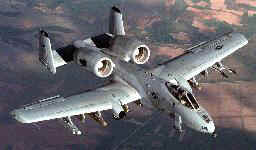 The
most effective CAS can be performed by high-flying aircraft using Fiber Optic Guided Bombs
unless an enemy has effective high-altitude air defenses. Using
traditional attack aircraft for direct strafing may be outdated against a modern
enemy. Suicide micro drones may appear from anywhere and crash into them. Modern lightweight fighter-attack jet aircraft have become too
expensive to risk in this role. Attack aircraft designed for this mission are
best, like the armored A-10 (right) or something cheaper like Rutan's ARES.
However, keeping costs in check is a major
factor. The basic A-10 has been upgraded with many sophisticated and
expensive systems while the US Air Forces slashes the inventory.
The
most effective CAS can be performed by high-flying aircraft using Fiber Optic Guided Bombs
unless an enemy has effective high-altitude air defenses. Using
traditional attack aircraft for direct strafing may be outdated against a modern
enemy. Suicide micro drones may appear from anywhere and crash into them. Modern lightweight fighter-attack jet aircraft have become too
expensive to risk in this role. Attack aircraft designed for this mission are
best, like the armored A-10 (right) or something cheaper like Rutan's ARES.
However, keeping costs in check is a major
factor. The basic A-10 has been upgraded with many sophisticated and
expensive systems while the US Air Forces slashes the inventory.
The US military has no low cost "disposable" attack aircraft, although the AT-6C is an option. The US military lost over 3600 fixed-wing aircraft during the Vietnam war, most to simple unguided weapons. Since aircraft are far more expensive and far less numerous, while small precision guided weapons now exist, CAS against a modern army seems foolish. As a result, the US Navy and Air Force now prefer using long-range "glide bombs" like the JSOW that can be released from up to 70 miles away. In that case, simple C-2s can drop these rather than $100 million F-35s.The future of CAS is unclear. It may prove extremely effective in future wars as it has in the past, or air defenses may down so many aircraft the idea is abandoned.
©2015 www.G2mil.com